DISCLAIMER
the content of these galleries is a private property
neither the text nor the pictures may be republished, nor used for any purpose, without the author's permission

|
back to the
GALLERY INDEX
|
~~ Gallery 18 ~~
Regional Cards
China and Hong Kong
· page 1 ·
Historical Notes
Money-suited Cards
part I
|
back to the
GALLERY INDEX
|

|
my thanks to
Jeff Hopewell, ChungPang Lai,
John McLeod and Dylan W.H. Sung
for their precious help
NOTE
Due to romanization (i.e. the spelling of Oriental words in Western letters based
on their original sound)
some names might have different versions. In these pages the standard system
presently used (Pinyin)
has been adopted, including some names quoted from the works of
other authors.
For some names the original Chinese spelling is also shown.
Since Mandarin is the official language of the country, though many playing cards
are from areas where Cantonese, Hakka and other dialects are spoken,
the names are given in their most common form.
INTRODUCTION
In China several traditional cards exist, most of which are still in use, especially in
the provinces located along the coast.
Most of the packs are made of a larger number of cards than the European ones.
They might look peculiar to Western eyes, both for their dimensions, usually thin and long,
thus quite smaller than Western ones, and for the variety of illustrations and personages
they feature.
 |
The reason for such a narrow shape is very likely the use of holding many cards in hand
at the same time, overlapped in a "vertical" arrangement (i.e. not in "fan" position),
so that one of their ends remains visible: their indices, where present, are consistent with
this arrangement, being located at both ends of the cards.
|
Another typical feature rarely encountered in Western cards is that,
with few exceptions, the subjects of a Chinese deck are duplicated several times
(how many times depends on the pattern or even on the different editions), and this
explains how some decks may contain over 150 cards.
Their backs, instead, are more often plain, i.e. of only one colour, but some patterns do
have geometric motifs, in a more Western fashion.
Many decks are sold either wrapped, or bound together by a
strip of paper with the company's name, or even tied with a string, as shown in these
pictures. A cardboard box too is sometimes used. |
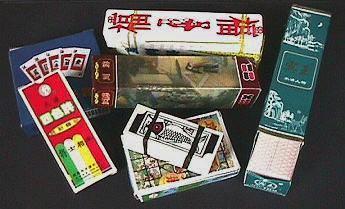 |
The Chinese patterns may be grouped into a number of main families, known as
money-suited cards,
chess cards,
domino cards and
character cards,
according to the kind of suits and to the structure of the deck.
However, these are Western names and do not correspond to the way Chinese players refer to
them; furthermore, even within one same group each of these patterns should be considered
individually, because the number of cards they are made of, the geographic area they belong to,
and the games played with them are different.
Since the literal translation of the names of decks, suits and single cards
in Chinese does not always match their Western equivalent, both the original version and the less
"exotic" one (provided the latter does exist) are reported in the text.
Lastly, a note of folklore. The Cantonese have a saying: good things come in pairs. This is clearly
reflected by the names of the brands and the decorative details featured in couples
by several cards, an element of good luck that characterizes decks from the south-east
of China and Hong Kong (as seen in the picture on the right). |

playing card brands from south-eastern China and Hong Kong |
For the sake of a faster loading of the pictures, this gallery is divided into monographic pages, as follows:
| HISTORICAL NOTES · MONEY-SUITED CARDS (part I) . . |
page 1 |
| MONEY-SUITED CARDS (part II) . . . . . . . . . . . . . . . . . . . . . . . . |
page 2 |
| CHESS CARDS . . . . . . . . . . . . . . . . . . . . . . . . . . . . . . . . . . . . . . . . |
page 3 |
| DOMINO CARDS . . . . . . . . . . . . . . . . . . . . . . . . . . . . . . . . . . . . . . |
page 4 |
| CHARACTER CARDS . . . . . . . . . . . . . . . . . . . . . . . . . . . . . . . . . . |
page 5 |
(skip the historical notes)
HISTORICAL NOTES
China is the country in the world where playing cards were first created, probably
hundreds of years before they reached Europe, but the scarce sources available
and the inevitable linguistic difficulties give reason for many gaps still left
in the history of early Chinese cards.
At the end of the 19th century, anthropologist S.Culin and sinologist W.H.Wilkinson
investigated the patterns extant by those times, and compared them with earlier decks and
single cards found in museums and collections (the pictures shown along the historical notes
are original illustrations taken from a publication by Wilkinson dated 1895).
Their reports clearly show that playing cards in China have not developed in time as much as
they did in Europe, and that their suits and subjects have remained substantially unchanged.
 |
DOMINO PATTERNS
The popular variety of cards featuring black and red dots sprang from domino sets, or
 Ku Pai Ku Pai
("bone tiles") in Chinese, whose pieces were - and still are - quite
similar to the Western ones (see page 3).
Sometime around the 12th century (a rather approximate dating), decks made of pasteboard
began to appear in place of the usual ones, of bone or ivory.
Although this may sound strange, the Chinese make little distinction between
"tiles" and "cards", the latter simply acting as an alternative shape of the former, so that
both of them are referred to as pai, a generic word for labels, tiles, cards, tags, etc.
Unlike actual tiles, though, Chinese domino cards developed through the ages into different
patterns, according to the number of duplicate subjects for each combination of dots and to the
size of the cards (ranging from very small to rather large). They are described in
page 3. |
MONEY-SUITED PATTERNS
Another early pattern is known as
 Gun Pai
Gun Pai
("stick cards" or "cane cards"), likely referring to their shape.
Wilkinson maintained that these cards were created from early books, whose pages were
made individually detachable for an easier reference; later on, their use as an amusement
would have caused their size to be reduced.
According to his theory, this kind of books came into use in China by the mid 8th century; if this proved
correct, the
Gun Pai might have been created before the domino cards.
The structure of this pattern was described as based upon three suits, whose cards
featured signs from 1 to 9 (but one suit had numerals). The suits were
identified by Wilkinson as  Jian Jian (or
Qian) "coins, money",
 Tiao Tiao
with a meaning of "long things, sticks", and  Wan Wan
meaning "myriads, 10,000".
Three more subjects named  Qian Wan Qian Wan ("Thousand Myriads",
also known as "Old Thousand"),
 Hong Hua Hong Hua ("Red Flower")
and  Bai Hua Bai Hua ("White Flower") completed the set.
A full deck contained four duplicates of each subject (120 cards in total) plus, in
some editions, a variable number of special loose cards, up to six per pack, whose
function in play - according to Wilkinson's report - was the same as
that of Western jokers, i.e. they acted as wildcards that could replace any standard
subject.
An identical composition is still found today in the DongGuan pattern, described in
this page. |

early 9 of Myriads |
As an alternative name for these cards, Wilkinson's report mentions
 Ma Jue
Ma Jue, what
in Western countries is now called
Mah Jong, basically a variant of the classic
money-suited scheme, described in detail in
page 2. However, it is now believed that the game of
Mah Jong was born much later than the
Gun Pai, probably sometime during the
18th or 19th century.
Despite the shape, the length, the graphic style, the use of indices, etc. of old
Gun Pai decks appear rather heterogeneous, they belong to one same pattern,
the ancestor of the three-suited Chinese and Vietnamese money cards now extant.

3 of Coins (or Cash) |
Lastly, both Culin and Wilkinson described a third early pattern, labelled by the latter
author with the Cantonese name of
 Lat Chi Lat Chi
("waste paper"). Quite similar to the Gun Pai, these decks had four suits instead of three:
"coins", "strings", "rouleaux" and "lakhs" (whose meaning is "hundred thousands"), according to
Wilkinson. Culin, instead, reported them as "coins", "strings", "ten thousands" and "tens".
In these cards the actual suit names were usually featured:
 Wen Wen (i.e.
Cash, the least valuable old Chinese coins, with a hole in the center),
 Suo Suo ("strings", on which such coins used to be strung),
 Wan Wan ("myriads", or "10,000"),
and  Shi Shi
("tens, 10"). An example is shown in the picture on the left
Also these cards featured values from 1 to 9. Wilkinson specified that the 1s of both the
highest and lowest suits were called "100 children" and "ace of Coins". |
Two more subjects belonged to the pack: one of them matched the
Gun Pai's "White Flower", and the other card likely corresponded to the
"Red Flower". All the 38 cards of these packs were single (no duplicated subject).
Today's
Hakka cards, see
page 2, and
the Vietnamese
Bâ´t deck, described in the South-East Asian
gallery -
page 3, practically have the same
composition.
It is not possible to define whether the
Gun Pai or the
Lat Chi
was the original pattern from which the other one sprang in a second time, but there is
little doubt that they shared a common ancestor.
Recently, scholar A.Lo reported sources from the mid 15th century and the late 16th century
in which two four-suited patterns, one with 38 cards and one with 40 cards respectively,
are described in detail. The first one matches Wilkinson's
Lat Chi;
the 40-card deck, instead, has two additional subjects, and is referred to as for the game
of
Ma Diao, whose phonetic resemblance with
the aforesaid
Ma Que (or
MahJong) is likely not a coincidence.
THE TURFAN CARD
The oldest known Oriental playing card was found in 1905 in XinJiang province (Central Asia, presently nort-western China), by an archaeological site near the city of Turfan, whence its present name. It is now held by the Staatliches Museum für Vo1kerkunde, in Berlin (Germany).
 |
Unfortunately, the age of this card cannot be assessed, although it is believed to be several centuries old. It might even be the oldest extant in the whole world, but no evidence supports this claim. Therefore, this specimen tells us much more about where such cards were used, rather than when this happened.
Whatever age it may belong to, the striking resemblance with some of the subjects found in modern money-suited decks indeed suggests a connection; the stylized faces featurd on such cards represent the personages of a popular novel called The Water Margin ( Shui-hu Zhuan). The same personages are also commonly borrowed by other types of playing cards, particularly the Chuan Pai (a Chinese domino card variant) and Poker decks, in which their full figures are used as decorations in the central part of the card. The novel itself may provide a clue for the dating: it was written in the 14th century, and considering that some further time should have elapsed before its personages became renowned throughout the country, we may speculate that these faces should have not appeared on Oriental playing cards any sooner than during the same century, or eventually later. But this time limit would only be correct in the case the portrayed subject really was a character from The Water Margin. |
The Turfan card is consistent with the subject found in money-suited decks called Red Flower (see details in the following paragraph), and also the shape of the card seems to match that of modern Chinese decks.
Another unsolved question is "where did the card come from?".
In fact, in XinJiang province, once Chinese Turkestan, the language spoken was (and still is) Uyghur. Originally, it was spelt with an archaic script called Orkhon, then replaced with the Arabic one in the 16th century, and finally in the 20th century with both Western and Cyrillic alphabets. Chinese glyphs, such as the ones featured at both ends of the card, were never used. Therefore, this specimen may have come to Turfan from further east, maybe left behind by soldiers or by merchants; elseways, it may be the proof of a very early pattern, but already popular up to the point of being known in Central Asia, whose design (including the glyphs) would have remained steady, regardless of the geographic area where the cards were printed and/or used. |
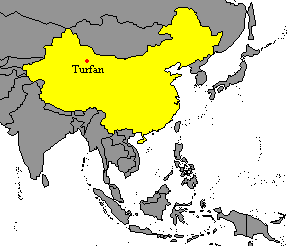 |
MONEY-SUITED CARDS
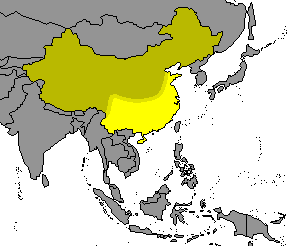 |
Money-suited cards is the name given to the most important group of Chinese patterns.
It was inspired by the old local coins, to which the graphic look of the suits is related.
These patterns are popular especially in the regions along the country's central and
southern areas (see map).
The main features of the group are:
- three suits, given the Western names of Coins, Strings and Myriads;
- values running from 1 to 9, plus a number of honour cards, of higher rank;
- some decks also have one or more special subjects.
Also a few 4-suited patterns, such as the Hakka cards
and the Vietnamese Bâ´t cards, belong to the
money-suited family (for the latter pattern see the Vietnamese gallery). |
- Coins suits in this group usually feature a stylized pattern related to old Chinese coins
(the ones with a square hole in the center). The name of such coins, Cash, is also alternatively
used to indicate this suit.
- The Strings, instead, show these coins threaded up on a string, as
Chinese people used to carry them (i.e. a striped pattern represents these threads as
seen from aside). Symbolically, Strings are equals to 100 coins.
- the cards of Myriads have stylized patterns inspired by Shui-hu Chuan ("The Water Margin"), a
well-known 14th century fictional story written in Chinese vernacular language.
|
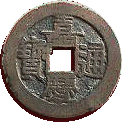
the old Chinese Cash that
inspired the money-suited system |
the wan (or man)
character,
in ordinary and
official spelling |
|
Myriads are the only cards whose values are not stated by the number of suit
signs (or pips), but by Chinese numerals from 1 to 9. The name of this suit
comes from the character wan (or
man in Cantonese dialect), meaning either
"ten thousand" or "myriads, multitude", which in some patterns appears next to the
value's numeral.
Since all Chinese numerals can be spelled in two forms, the ordinary one and the official
one (more elaborate), in the cards of Myriads the number expressing the value is always found in
ordinary form, while the suit character (wan) can be found in either of the two,
as shown on the left. |
In other card patterns, instead, the sign of the Myriads suit is a different
character, guan (Cantonese gun), shown on the right,
whose literal meaning is "to pierce, to pass through", but also meaning "a string
of 1,000 coins". |

Guan |
In spite of being different characters, these two may be considered as "interchangeable"
signs for the same suit. In fact, Wan is used in short for "10,000 Guan" (i.e.
10,000 x 1,000 coins, or 10 million coins). Furthermore, the suit of Guan
is referred to as Wan by players, and these two signs (or suits) never appear in the
same deck.
In four-suited patterns (such as the Chinese Hakka or the Vietnamese Bâ´t )
there is a further suit of higher rank, named Tens, which actually means "tens of myriads"
(i.e. 100 million coins).
Such a numerical interpretation of the suits is proven by the rank they have
in some games, which goes from Tens (if present) or Myriads (either Wan or
Guan) to Strings, down to Coins, i.e. single units.
Only Mah Jong suits partially diverge from the aforesaid scheme (see table on the right
and relevant paragraph further down in the page), but the signs adopted still show
a graphic resemblance with the traditional ones, having sprung from the latter.
|
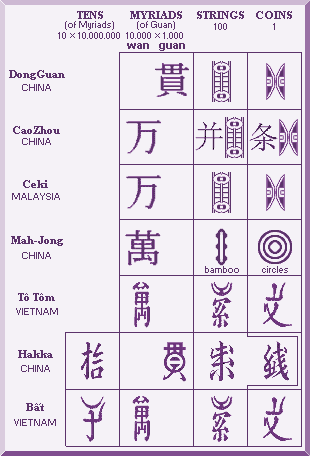
the shape of signs in different money-suited patterns |

DONG GUAN CARDS
NOTE
all DongGuan cards shown come from a
Double Elephant Brand edition, by Guan Huat (Hong Kong)
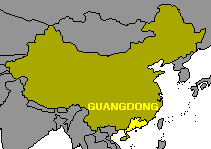 |
The name of this pattern simply means "DongGuan cards" (referring to a town in the
province of GuangDong, southern China.
The deck contains 124 cards, divided into three suits named
Wen,
Suo and Wan,
equivalent to the aforesaid Coins, Strings and Myriads. |
In this pattern the suit of Wan (Myriads) is shown by means of
the character guan, previously described, though its name
has remained unchanged. It features very stylized faces, representing
personages from "The Water Margin", as explained in the introduction.
The values of these cards run from 1 to 9.
The 9 of Strings is different from other subjects because it features a red stamp (or seal). |

1, 5 and 9 of Wan (Myriads) |
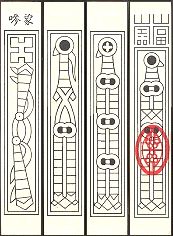
2, 3, 7 and 9 of Suo (Strings) |

the Gui card, Da Hong,
Ba Shu and Xiao Hong, or
Ghost, Old Thousand,
White Flower and Red Flower
|
This deck also has three additional or honour cards named
Da Hong ("big red"), Xiao Hong ("small red")
and Ba Shu ("eight bundle"), probably referring
to the eight chevron-like elements in the upper part of the card. Other
known names for these cards are Old Thousand,
Red Flower and White Flower,
respectively. The first two of them feature a couple of red stamps, similar to the single one
featured by the 9 of Strings; the White Flower instead has no stamp and shows a
stylized white flower in a pot.
The masque-like pattern featured by both the Da Hong (a.k.a. Old Thousand) and the
Xiao Hong (a.k.a. Red Flower) has graphic resemblance with the cards
belonging to the Wan (Myriads) suit: in fact, also these ones represent
personages from the same epic novel.
There is a further special card in the deck, named Gui
(Cantonese Gwai), meaning "devil" or "ghost", featuring a small male figure that
wears traditional Chinese clothes. This is the only subject whose illustration is not in black & white, except
the red seals, and its purpose is that of the special loose cards in early Gun Pai decks
(see the historical notes). |
In the DongGuan deck, each of the cards mentioned above is repeated four times.
While in the Wan (Myriads) suit values are indicated by numerals, in the other
two suits this is shown by pips. To a westener's eye, some of these arrangements
might be difficult to read. In the Strings suit, for instance, what has to be counted is the
number of "ladder-like" or "railway-like" stripes, which represent threads of coins, as mentioned
above in the introduction; the 9 of this suit does not follow this criterium, but
it can be easily told all the same because of its red stamp (see previous picture).
Also values shown by the Coins suit are not so easy to read, as the illustrations are
very stylized, and in most cards only a section of each coin is shown. |

1, 4, 6 and 9 of Wen (Coins) |
DongGuan cards are used for playing
DaFu and
QuanDui; rules for the
latter game can be found in the relevant page of
John McLeod's
website.
Money-suited cards found in various parts of China comply to less strict schemes than
Western patterns; in fact, although all packs have traditional suits, with pip
cards from 1 to 9, the number of times each subject is duplicated and the quantity
and illustrations of the special cards (if any) are subject to changes.
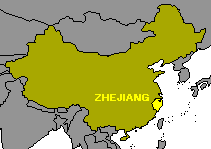 |
Furthermore, these decks are often manufactured and marketed on a local
basis (up to recent times, in China there was no company large enough to print and sell
cards all over the country). Therefore, it is not unlikely for some patterns to bear more
than one name in different parts of China, while other patterns do not even have a specific
name, being generically referred to by the local players as "cards", "paper cards", or
other generic names of the like.
This is the case of the pattern featured in the following pictures, that comes from the
province of ZheJiang, merely labelled as "plastic cards for amusement". |
The deck contains the same subjects as the aforesaid DongGuan pattern,
including Old Thousand, Red Flower and White Flower, but in this case
each card is repeated five times instead of four.

samples from the suits of
Coins (top row), Strings
and Myriads (bottom row) |
There are also five special subjects featuring human figures, whose names read
the Major, the Minor, Money, String and Myriad (the last three evidently
refer to the suits which, however, they do not belong to). A sixth special card has no
human figure but a rather large vertical text, merely a certification of the product's
quality ("meeting the standard").
These six subjects, shown at the bottom of the page, are single.
All together, the cards in the deck are 156.
Out of five sets, two of them and the six special cards are illustrated in colour,
while all the other ones are in black and white. Samples of the latter are shown
in the picture on the left (i.e. the card to the far right in each row). |

Old Thousand, Red Flower,
and White Flower |
On both ends of each card is a small black rectangle with a white pattern inside: these
are indices, from whose shape both the value and the suit of the card can be told. The
system is shown in full in the diagram below.
 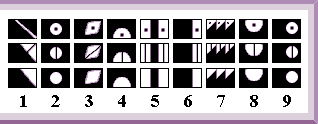
note how Coins and Strings differ from Myriads by tiny
graphic details (dots, lines), that somewhat recall the shape of the suit
Similar index systems are used by other money-suited patterns
(see also the South-Eastern Asian gallery).
Instead, the Old Thousand, the Red Flower and the White Flower,
as well as the special subjects, feature different indices. The latter have them in
yellow; among them, the top index of the "meeting the standard" subject reads "king card". |
Besides the use of coloured subjects, other unusual details are found in
this pattern. For instance, the absence of red stamps on the Old Thousand, Red Flower
and 9 of Strings. One more curious feature is the graphic look of
the Strings suit: the 3-dimentional rendering of the coins strung together is somewhat
reminiscent of the cudgels in the suit of Batons belonging to the
central-southern Italian and Spanish cards
(see the relevant galleries).
Also the faces of the personages in the suit of Wan, yet naive, are less stylized than
the ones found in the DongGuan pattern. |
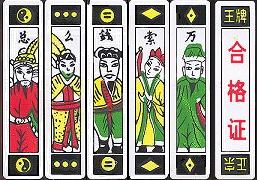
the special cards: (from the left) the Major,
the Least, Money, String, Myriad and King Card |
go to
OTHER GALLERIES






















or back to

INTRODUCTION
AND HISTORY
|

MULTI-LANGUAGE
GLOSSARY |

THE FOOL &
THE JOKER |

INDEX
TABLE |

REGIONAL
GAMES |

PLAYING CARD
LINKS |